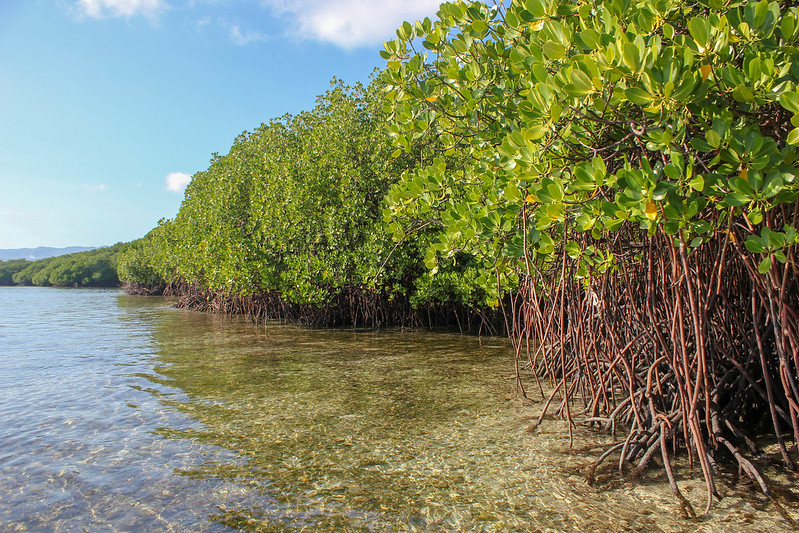Here’s how shrimp farming is restoring mangrove forests
Mangroves play a key role when it comes to climate adaptation, flood defense and carbon capture. Shrimp farming has damaged much of the world’s mangrove forests but a change in practice can reverse this.
S hrimp farming is big business, with about 4.5 million tonnes produced that way last year alone. That’s more than the amount caught by fishing.
This kind of aquaculture is a resource-efficient way of producing food. But there is concern about the effect of aquaculture on marine environments. About 70% of Indonesia’s mangrove forests, for example, have been damaged or degraded by the practice, according to the Global Mangrove Alliance (GMA).
With 3 billion people around the world dependent on seafood as their primary source of protein, and the world’s population expected to grow by 2 billion by 2050, increasing this kind of food production sustainably is a pressing issue. Following a nature-based solutions (NbS) approach can make sure that this is the case.
One initiative working to combine NbS and aquaculture is Selva Shrimp, a program managed by Blueyou Consulting. First launched in Viet Nam, the project combines small-scale farming with active measures to protect the environment. This way, it’s not just producing food sustainably – it’s creating jobs and protecting livelihoods, too.
Backed by the IUCN’s Blue Natural Capital Financing Facility, Selva Shrimp is piloting the inclusion of NbS into shrimp farming in Indonesia to meet the world’s growing appetite for consciously produced seafood. The effort aims to demonstrate the financial sustainability of such projects and their attractiveness, in order to show the world a path towards rectifying negative impacts generated during decades of unsustainable farming practices.

Mangroves have been damaged by fish farming practices, leading to devastating consequences of coastal erosion and floods. Photo by Steven Lutz, GRID-Arendal/Blue Forests on Flickr.
The vital role of mangroves
Located in the Indonesian part of the world’s largest island, Borneo, Selva Shrimp Kalimantan puts additional revenues back into restoring the area’s coastal mangrove forests.
The company says everything the shrimp need to grow is provided by the mangroves, and that its programme provides incentives for farmers to change existing practices. Among these are substantially increased harvest sizes through improved farming practices and healthier environments, and a higher price for this premium product. Harvested mangrove areas are reforested with young trees, it says.
At the same time, the forests remain a liveable habitat and food source for many other aquatic species, including crabs, oysters and mudskippers.
The company wants to expand the project across the region. In total, Indonesia boasts a fifth of the world’s mangrove forests, according to the GMA, so schemes such as this could have a significant impact.
Mangrove forests are critical to the economic and food security of many coastal communities, according to the United Nations. They also provide a vital defence against floods and storms, and have a crucial role in sequestering carbon from the atmosphere.
Benefiting livelihoods and communities
The benefits of initiatives like Selva Shrimp can spread wider than just those tending the shrimp farms, providing additional employment throughout the economy.
Farming shrimp without antibiotics, feed or chemicals produces an organic product that commands a premium price on world markets – and the additional revenue generates employment, creating jobs for some of the world’s poorest people.
One study found that organic shrimp farming in Bangladesh had enabled even small-scale organic shrimp farmers to create jobs for local people.
The report, from Vienna’s University of Natural Resources and Life Sciences, said that as well as direct employment in maintaining shrimp farm infrastructure, new jobs were created as financially successful farmers needed hatcheries, nurseries, ice and processing plants to support their businesses.
And not just the poorest benefit. The paper concluded: “In Bangladesh, organic shrimp aquaculture has generated substantial employment for educated people, as well as ensuring several diversified working opportunities.”
Hope for the future
Aquaculture plays an important role in supporting livelihoods, employment and local economic development among coastal communities in many developing countries, according to the United Nations Food and Agriculture Organization (FAO). It produces almost half of the world’s fish supply.
In total, more than 20.5 million people are employed in aquaculture worldwide, a figure which has been growing steadily since 2000, with Asia accounting for the bulk of jobs in the sector at over 19.6 million.
And despite the environmental concerns around some practices, in the past three decades there has been “transformational change” in reducing the impact of shrimp farming, according to the WWF, with shrimp farms of all sizes adopting the rigorous standards set by the Aquaculture Stewardship Council.
As well as demanding strong environmental safeguards, ASC accreditation involves complying with minimum standards for wages, working conditions and community consultation and engagement.
The ideas presented in this article aim to inspire adaptation action – they are the views of the author and do not necessarily reflect those of the Global Center on Adaptation.